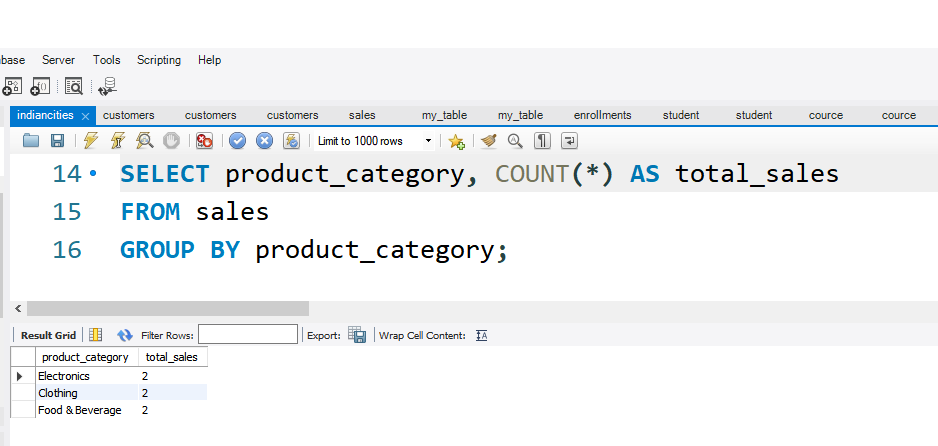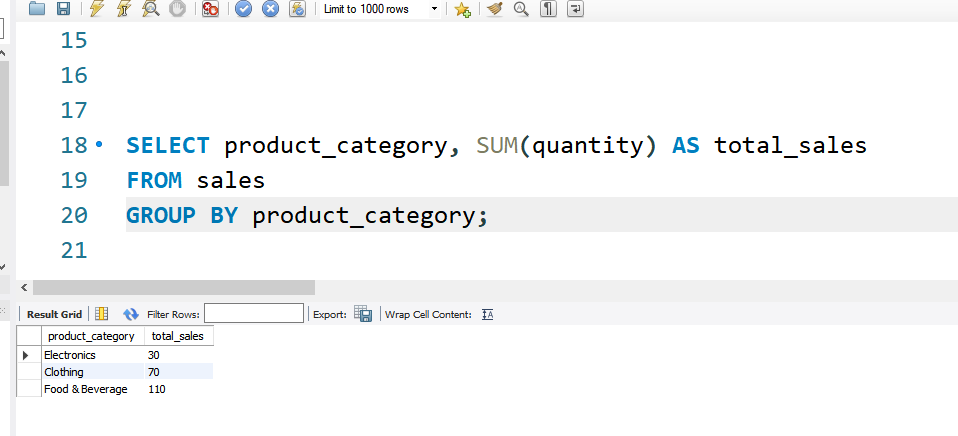Difference Between ORDER BY and GROUP BY: A Step-by-step
What is the GROUP BY clause in SQL?
The GROUP BY clause in SQL is used to group rows in a table based on the values of one or more columns. This can be useful for summarizing data or identifying trends. For example, you could use the GROUP BY clause to group rows in a table of sales data by product category to see which categories are selling the best.
Here is a simple example of how to use the GROUP BY clause in SQL:
Create a table:
CREATE TABLE `sales` ( `product_category` VARCHAR(255) NOT NULL, `quantity` INT NOT NULL );
Insert data into the table:
INSERT INTO `sales` (`product_category`, `quantity`) VALUES
('Electronics', 10),
('Electronics', 20),
('Clothing', 30),
('Clothing', 40),
('Food & Beverage', 50),
('Food & Beverage', 60);
Use the GROUP BY clause to group the rows by product category and count the number of sales for each category:
SELECT product_category, COUNT(*) AS total_sales FROM sales GROUP BY product_category;
example 1

The GROUP BY clause has grouped the rows in the sales table by product category and then counted the number of rows in each group. The results show that the Food & Beverage category has the most sales, followed by the Clothing category and then the Electronics category
You can also use the GROUP BY clause to summarize the data in each group using aggregate functions, such as SUM(), AVG(), and MAX(). For example, the following query uses the SUM() function to calculate the total sales for each product category:
example 2
SELECT product_category, SUM(quantity) AS total_sales FROM sales GROUP BY product_category;

As you can see, the GROUP BY clause is a powerful tool for organizing and summarizing data in SQL. By understanding how to use the GROUP BY clause correctly, you can write more efficient and effective SQL queries.
ORDERD BY IN SQL
The ORDER BY clause in SQL is used to sort the results of a SELECT statement in ascending or descending order. By default, the results are sorted in ascending order, but you can use the DESC keyword to sort in descending order.
To use the ORDER BY clause, you simply list the column(s) that you want to sort by after the ORDER BY keyword. You can also specify whether you want to sort in ascending or descending order by using the ASC and DESC keywords, respectively.
For example, the following query will select all of the rows from the sales table and sort the results by product category in ascending order:
Example 1
SELECT * FROM sales ORDER BY product_category ASC;

Exampe 2
SELECT * FROM sales ORDER BY product_category ASC, quantity DESC;

Grouby and orderby use together in sql
SELECT product_category, SUM(quantity) AS total_quantity FROM sales GROUP BY product_category ORDER BY total_quantity DESC;

You can use the GROUP BY and ORDER BY clauses together to generate a variety of reports and summaries. For example, you could use them to group customers by country and then sort the results by total spending, or to group products by category and then sort the results by profit margin.
The GROUP BY and ORDER BY clauses are powerful tools for organizing and analyzing your SQL query results. By using them together, you can create custom reports and summaries that meet your specific needs.
FAQ
The GROUP BY clause is used to group rows in a table based on the values of one or more columns, while the ORDER BY clause is used to sort rows in a table in ascending or descending order based on the values of one or more columns
You should use GROUP BY when you want to summarize data or identify trends. For example, you could use GROUP BY to group rows in a table of sales data by product category to see which categories are selling the best.
You should use ORDER BY when you want to organize the results of a query in a specific order. For example, you could use ORDER BY to sort the rows in a table of customer data by name in ascending order.
One common mistake is to use an unaggregated column in the SELECT clause that is not also included in the GROUP BY clause. This will result in an error.
Yes, you can use GROUP BY and ORDER BY in the same query. However, it is important to remember that the GROUP BY clause must come before the ORDER BY clause.
Yes, you can order by a column that is not included in the SELECT clause, but only if the column is also included in the GROUP BY clause.
Yes, you can order by an aggregated column, but the aggregated column must not also be included in the GROUP BY clause.


